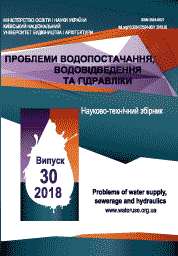Choosing energy-saving water supply technologies in the water supply network
DOI:
https://doi.org/10.32347/2524-0021.2018.30.48-56Ключові слова:
pumping station, water supply network, specific energy consumption, regulation of pump operationАнотація
Reducing energy consumption is one of the most important national economic problems in Ukraine. Since the water supply and sewage industry is one of the most energy-intensive, solving problems related to ensuring energy-saving of water supply is extremely necessary. The big deterioration of the plumbing networks in the settlements is causing heavy losses and secondary pollution of the water. The change of norms and regimes of water consumption and the characteristics of the structures of hydraulic interaction during operation leads to excessive pressures in the water supply system and the growth of its accident rate, not providing consumers with the necessary pressure of water and increase in material and moral damages. The operation of pumps in water supply systems is often beyond the limits of their recommended use. So, it has low efficiency and high energy consumption. That's why electricity consumption for water supply in Ukraine is significantly higher than in other European countries. It is possible to improve the situation by projecting new or reconstructing the existing structures of the water supply system using rational schemes, energy saving technologies and modern efficient equipment and materials throughout all the way of transporting water from the water source to the consumer, as well as determining economically feasible modes of operation of the structures with the least energy consumption. The article contains results theoretical research, and advice on choosing rational technological schemes water delivery in water supply networks and optimal modes of operation water supply facilities for minimizing unit costs of electricity by pumping stations.Посилання
Khoruzhiу, P. D., Khomutetska, T. P., Khoruzhiу, V. P. (2008). Resource-saving technologies of water supply. Kyiv: Agrarian Science, 534. [in Ukrainian].
Grabovsky, P. A., Karpov, I. P. (2016). Reduced cost of tap water. Problemy vodopostachannia, vodovidvedennia i hidravliky, 27, 99-104. [in Russian].
Kozhinov, I. V. (1978). Adjustment and intensification of the operation of urban water supply and distribution systems. Moscow: Stroyizdat, 112. [in Russian].
Leszov, B. S. (1991). Saving electricity in pumping units. Moscow: Energoatomizdat, 144. [in Russian].
Tkachuk, O. A. (2005). The main ways of reducing energy consumption in water supply and distribution systems. Visnyk NUVHP, 3(31), 323-328. [in Ukrainian].
Khomutetska, T. P. (2016). Energy-efficient water supply. Kyiv: Agrarian Science, 304. [in Ukrainian].
Petrosov, V. A. (2007). Water supply sustainability. Kharkiv: Factor, 360. [in Russian].
Novokhatnіy, V. G. (2011). Construction of pumping stations, taking into account the conditions of reliability. Naukovyy visnyk budivnytstva, 62, 216-220. [in Ukrainian].
Bunn, S. (2005). Optimal pump scheduling for East Bay Municipal Utility District. Oakland, CA, using the Aquadapt package, CCWI, Exeter, UK.
Dandy, G. C., Simpson, A. R. & Murphy, L. J. (1996). An improved genetic algorithm for pipe network optimization. Water Resour. Res., 32(2), 449-458. doi:10.1029/95wr02917
Eiger, G., Shamir, U. & Ben-Tal, A. (1994). Optimal design of water distribution networks. Water Resour. Res., 30(9), 2637-2646. doi:10.1029/94WR00623
Fantozzi, M., Lambert, A. (2007). Including the effects of pressure management in calculations of economic leakage level: Proceedings of IWA Special Conference «Water Loss 2007». Bucharest, September.
Fujiwara, O. & Khang, D. B. (1990). A two phase decomposition method for optimal design of looped water distribution networks. Water Resour. Res., 26(4), 539-549. doi:10.1029/ WR026i004p00539
Kessler, A. & Shamir, U. (1989). Analysis of the linear programming gradient method for optimal design of water supply networks. Water Resour. Res., 25(7), 1469-1480. doi:10.1029/ WR025i007p01469
Lambert, A. (2001). What do we know about pressure: leakage relationships in distribution systems? IWA Conference Proceedings on System Approach Leakage Control and Water Distribution Systems to Management, Brno.
Mackle, G., Savic, D., Walters, G., (1995). Application of genetic algorithms to pump scheduling for water supply. Paper presented at 1st International Conference on Genetic Algorithms in Engineering Systems: Innovations and Applications (GALESIA), London. doi:10.1049/cp:19951082
May, J. (1994). Pressure dependent leakage. World Water and Environmental Engineering, 10, 256-263.
Puusta, R., Kapelanb, Z., Savicb, D. A., Koppel, T. (2010). A review of methods for leakage management in pipe networks. Urban Water Journal, 7(1), 25-45. doi:10.1080/15730621003610878
Pearson, D. (2005). Searching for №2: How does pressure reduction reduce burst frequency: Proceedings of IWA Special Conference «Leakage 2005». Halifax, September.
Thornton, J., Lambert, A. (2005). Progress in practical prediction of pressure/leakage, pressure/burst frequency and pressure/consumption relationships: Proceedings of IWA Special Conference «Leakage 2005». Halifax, September.
##submission.downloads##
Опубліковано
Як цитувати
Номер
Розділ
Ліцензія
Автори, які публікуються у цьому журналі, погоджуються з наступними умовами:
a) Автори залишають за собою право на авторство своєї роботи та передають журналу право першої публікації цієї роботи, яка через 70 років після смерті останнього співавтора з дати публікації автоматично стає доступною на умовах ліцензії Creative Commons Attribution License, котра дозволяє іншим особам вільно розповсюджувати опубліковану роботу з обов'язковим посиланням на авторів оригінальної роботи та першу публікацію роботи у цьому журналі.
b) Автори мають право укладати самостійні додаткові угоди щодо неексклюзивного розповсюдження роботи у тому вигляді, в якому вона була опублікована цим журналом (наприклад, розміщувати роботу в електронному сховищі установи або публікувати у складі монографії), за умови збереження посилання на першу публікацію роботи у цьому журналі.
c) Політика журналу дозволяє і заохочує розміщення авторами в мережі Інтернет (наприклад, у сховищах установ або на особистих веб-сайтах) рукопису роботи, як до подання цього рукопису до редакції, так і під час його редакційного опрацювання, оскільки це сприяє виникненню продуктивної наукової дискусії та позитивно позначається на оперативності та динаміці цитування опублікованої роботи (див. The Effect of Open Access).


